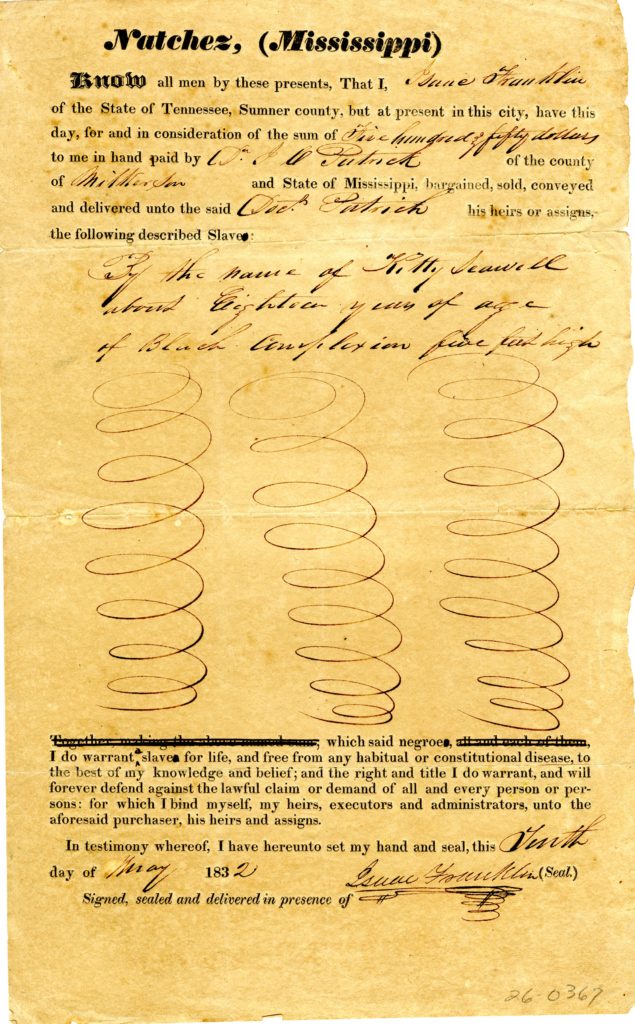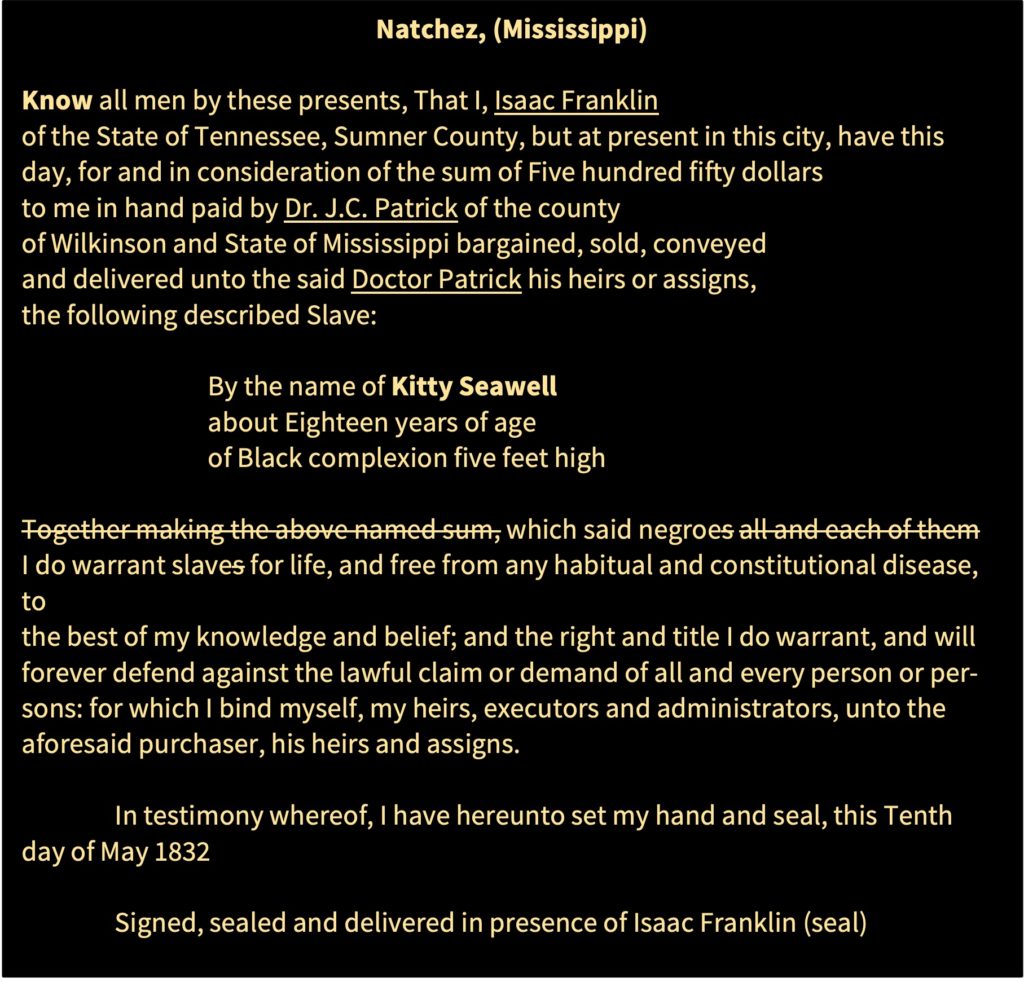In my blog series on Black Families of Edgefield Plantation I wrote about Dr. J. C. Patrick , the last owner of the plantation before emancipation. Patrick arrived in Woodville, Wilkinson County, Mississippi, in 1830 and married Eliza Chinn Connell in 1833. After the death of Eliza Connell’s husband and the subsequent death of their two teenage sons, the Patricks became sole owners of the estate which they called Edgefield.
In my continuing search for more info on Patrick I was surprised to find his name associated with the infamous slave trader Isaac Franklin. The Franklin & Armfield firm sold thousands of enslaved people from Virginia into Tennessee, Mississippi, and Louisiana plantations. Franklin had one of his headquarters in Natchez where he started the Forks of the Roads market.
Joshua Rothman in his recent book The Ledger and the Chain (1) goes into details on how Franklin, along with his family members and associates, were notoriously known for culling out young enslaved African girls from their families and bragging about raping and selling them all over the South to men for sexual pleasures.
In 1832, Franklin, then living in Natchez, wrote out a deed of sale for Kitty Seawell, an enslaved Black woman approximately 18 years old, to Dr. J.C. Patrick of Wilkinson County, Mississippi, for the sum of $550. (2)


The complete story of Kitty Seawell, an 18-year-old female born around 1814, sold in Natchez by a Virginia and Tennessee slave trader, may remain unknown. Who were her parents? Where was she born and under what circumstances? Why did she have the surname Seawell? How did she become a possession of Isaac Franklin? What happened to her after J. C. Patrick purchased her in 1832? Was she merged into the Edgefield plantation and became one of my ancestors?
I have not found her name in Isaac Franklin’s slave inventories (3) or in J.C. Patrick’s Wilkinson County, Mississippi, or West Baton Rouge Parish, Louisiana, plantation slave lists. Her story is an example of how various enslaved people were trafficked into early Mississippi and the Deep South. With the discovery of her name on this lone, isolated, Bill of Sale, the name Kitty Seawell will always be remembered and hopefully one day her story will be told.
Noted Sources:
- Rothman, Joshua D. The Ledger and the Chain: How Domestic Slave Traders Shaped America. First edition. New York, NY, Basic Books, Hachette Book Group, 2021.
- Isaac Franklin Slave Deed, MS26-0367. Rosenberg Library, Galveston, Texas. In the collection of the Galveston Texas History Center.
- Stephenson, Wendell Holmes. Isaac Franklin, Slave Trader and Planter of the Old South: With Plantation Records. Gloucester, Mass., P. Smith, 19681938.


Ohhhooo wow Alvin, ya have an image of an actual Isaac Franklin signature on an actual Bill of Sale putting him in Natchez!
The bill of sale looks like a standard form document used for sales of enslaves by Franklin and Armfield Company or any of their agents or any others.
So glad ya found this as ya keep digging and sharing ya “family’s chattel slavery history!”
My brother, can ya make a copy of this Bill of Sale for mi? Just have this cell phone to work email/internet with!
Asante Sana!
Ser. I will send you a hard copy. I was surprised to discover it housed at a Galveston, Texas, library with no other related documents. I thought it would be good to share with others who may not have seen a Bill of Sale for a human being.
So sad. So many stories lost.
Kristen. Yes this is a sad story. But each documented story can be used as a broader lesson. This lesson is hard: Enslavement meant the split-up of children from their parents; trafficking from Upper South to Deep South; buying and selling of children; and rape and subjugation of females.
Thanks, Alvin. Another informative blog. We know these atrocities happened, but putting a name to it makes it just that more real.
Thanks for reading.
Thanks Alvin
Do you know if Edgefield was ever know as Fountain Blue Planation. My mother who is now 101 years, great-grandmother’s name was Kitty and in some census records we found she was also called Kit. Kitty took on the name Patrick as far as can tell. This Kit or Kitty had a daughter name Rebecca, who was my great-grandmother. My mother also called the plantation Fountain Blue; but, from reading the information that you put together it sounds like the same place. We were always told that Kitty had children by Dr. Patrick. Not sure of one or both sons were also doctors.
Jennifer, Fountainbleau is located due north of Edgefield and Tilset, which were plantations owned by Patrick. Please contact me ASAP.
This is very interesting. You have asked some good questions, to which I hope you find the answers. Thank you, Sir.
Thanks for reading Melvin.
Wow Alvin,
…was there no limit to the deprived indifference?
As usual great research?
A.
Thanks Alice.
Thanks for sharing.
Thanks for reading.
Alvin, I have read all of your blogs and great research as usual. A month ago, I inquired about Arnett connections in our Wilkinson County Facebook group. I also mentioned that there were Patrick surname connections to that line. You asked me about the Patrick’s and I don’t remember responding. I think I forgot how they are connected. I also forgot that you have been blogging about the Patrick’s. I will follow up this week. Best
Thanks Gerri.
I have over 30 DNA matches that have the surname Patrick in their trees. Do you think it’s possible that J.C. Patrick could have fathered any of his female enslaved including Kitty Seawell?
Gerri. I don’t know about J.C. Patrick but his son Dr. Robert Patrick (1845-1932) took over the operation of the plantation after Emancipation. He never married and was said to have fathered children at Edgefield.
Thank you for giving Kitty a voice in your blog. Thanks to your platform, she will not be forgotten.
Thanks Vernita.
Thanks for sharing.
Hey Isabella. Thanks for reading.
These documents make real the lives of the many simply labeled as “slave” by merchants and enslavers. Research like that which you’re doing for your family history is ensuring that the Kitty Seawells will never be nameless to us. Keep digging and writing about your findings!
Thanks Vicki. I always appreciate your comments.
Thank you for your research and naming individuals and Black families of the Edgefield Planation. You inspire me to further research one of the plantations of my paternal family. BTW I ordered the Rothman book (I only hope I can read it),
Thanks Sandra.